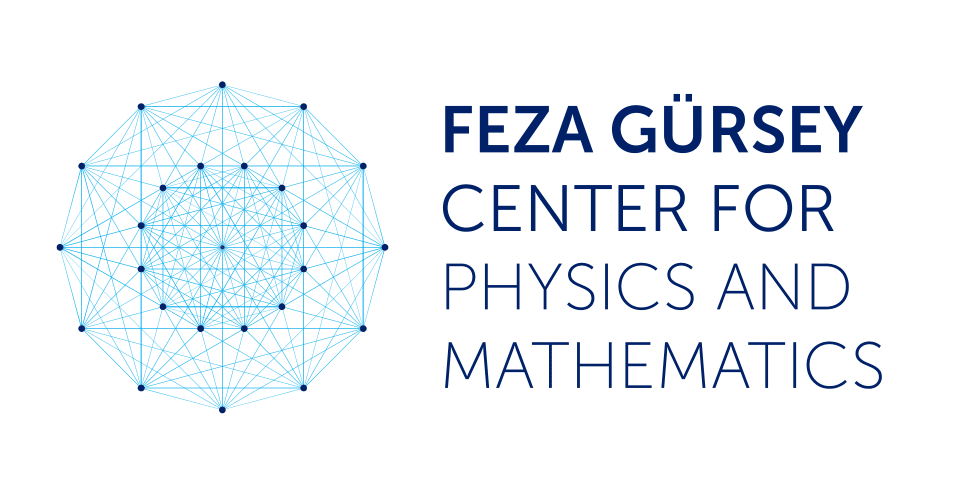
Geometry in İstanbul
This workshop will take place on April 10-11, 2023 at Feza Gürsey Center for Physics and
Mathematics which is located in the Kandilli campus of Boğaziçi University. For
transportation and other practical information please check here.
Below is the schedule . Click for abstracts!
April 10, 2023 (Monday)
Abstract: I will survey some recent results on the classification of singular Fano threefolds, focusing, on the case of Fano threefolds with terminal singularities.
Some new results will be presented.
10:00-11:00 Yura Prokhorov (Steklov Mathematical Institute) - On the classification of singular Fano threefolds
11:30-12:30 Alex Degtyarev (Bilkent University) - Singular real plane sextic curves without real points
Abstract: There are 105 irreducible families of smooth Fano threefolds,
which have been classified by Iskovskikh, Mori and Mukai. For each
family,
we determine whether its general member admits a Kaehler-Einstein metric
or not.
This is a joint work with Carolina Araujo, Ana-Maria Castravet, Ivan
Cheltsov,
Anne-Sophie Kaloghiros, Jesus Martinez-Garcia, Constantin Shramov,
Hendrik Suess and Nivedita Viswanathan.
14:00-15:00 Kento Fujita (Osaka University) - The Calabi problem for Fano threefolds
Abstract: (joint work with Kharlamov)
We present real enumerative invariants not sensitive to changing the
real structure on del Pezzo surfaces
of degrees 1,2 and 3.
These invariants are obtained by signed summation of Welschinger
invariants for a fixed anticanonical degree.
The signs come from certain canonical Pin-structures on the real loci
of these surfaces.
15:30-16:30 Sergey Finashin (METU) - On wall-crossing invariance of certain sums of Welschinger numbers
April 11, 2023 (Tuesday)
Abstract: We give a survey on conjectures that relate Hodge structures of Fano varieties and mixed Hodge structures
of log Calabi--Yau varieties related to them with some filtrations and Hodge structures constructed from Landau--Ginzburg models that are mirrors
to the Fano varieties.
10:00-11:00 Victor Przyjalkowski (Moscow State University) - P=W and KKP
Abstract: A non-degenerate square matrix with positive integer entries defines an invertible polynomial – a polynomial with as many terms as the number of variables. To study the monodromy of a hypersurface defined by an invertible polynomial, we propose to consider its dehomogenization through torus action so that it become Delsarte polynomial. We will be concerned with a generalized version of Dubrovin’s conjecture on the Stokes matrix associated to the Delsarte polynomial.
Firstly, we remark the equivalence between oscillating integral for Delsarte polynomial (Landau-Ginzburg model) and quantum cohomology of a weighted projective space P. Secondly,we verify a correspondence between the Stokes matrix of oscillating integral and the Gram matrix of the full exceptional collection on P. By means of the Laplace transform, the oscillating integral turns out a period integral of the Delsarte polynomial hypersurface that can be understood as Pochhammer hypergeometric function. We apply the theory of hypergeometric functions to calculate the monodromy of the period integrals then the Stokes matrix of their inverse Laplace transform.
11:30-12:30 Susumu Tanabe (Galatasaray University) - Period integrals associated to an invertible polynomial
Abstract: In a previous work with M.Bhupal, we proved that each minimal symplectic filling of any oriented lens
space, viewed as the singularity link of some cyclic quotient singularity and equipped with its canonical
contact structure, can be obtained from the minimal resolution of the singularity by a sequence of
symplectic rational blowdowns along linear plumbing graphs. Here we give a dramatically simpler
visual presentation of our rational blowdown algorithm in terms of the triangulations of a convex
polygon. As a consequence, we are able to organize the symplectic deformation equivalence classes of
all minimal symplectic fillings of any given lens space equipped with its canonical contact structure,
as a graded, directed, rooted, and connected graph, where the root is the minimal resolution of the
corresponding cyclic quotient singularity and each directed edge is a symplectic rational blowdown
along an explicit linear plumbing graph. Moreover, we provide an upper bound for the rational
blowdown depth of each minimal symplectic filling. (This is a joint work with M. Bhupal)
14:00-15:00 Burak Özbağcı (Koç University) - Rational blowdown graphs for symplectic fillings of lens spaces
Abstract: We present a new version of tropical-to-complex correspondence theorem. Given a regular tropical curve C in R^N passing through a collection of points P, we realize each component of C-P by a compact holomorphic curve with smooth boundary on the corresponding fiber tori in C*^N. In other words, the holomorphic curve is cut to individual pieces whose amoebas have pinching points at P. The regularity condition holds automatically if N=2, and the curve is immersed. This version of the tropical correspondence theorem is motivated by a question of Cheuk Yu Mak and Ilia Zharkov.
15:30-16:30 Grigory Mikhalkin (University of Geneva) - Tropical correspondence broken by Lagrangian tori
Organizers : Ivan Cheltsov, Umut Varolgüneş
These events are partially supported by TÜBİTAK grant number 121C034.